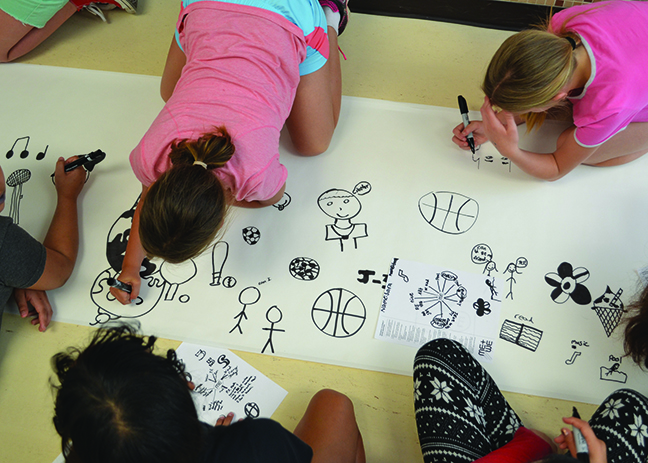
Assistant Professor of Design Aaron Sutherlen taught the "Me+We” Summer Design Workshop in June, in association with Lincoln Public Schools’ Culler Middle School’s Community Learning Center.
The workshop featured projects intended to bolster a student’s ability to recognize their own personal strengths and provide opportunities that explore how best to avail those qualities in order to successfully integrate into the larger learning community.
Sutherlen taught nearly 100 students in the workshop, who are transitioning from 6th grade into middle school. Sutherlen alternated between teaching at Culler and having the students come to the School of Art, Art History & Design to work in the larger studios on campus.
“Every summer Culler Middle School and their Community Learning Center has a summer workshop in order to help students who are not only transitioning from sixth grade into middle school get their feet under themselves and make that transition more smooth,” Sutherlen said. “It’s also an opportunity for a number of the students who are coming into the community from outside of Lincoln, some of them from other countries, get a bit more familiar and more comfortable with what to expect.”
Included in the workshop is an option for students to sign up for this four-week art and design workshop that Sutherlen taught.
“It’s gone really well,” Sutherlen said. “The kids are so enthusiastic. Some of them have had very little exposure to doing any sort of art- or design-based projects, but that sort of infectious, 12-year-old’s enthusiasm is why it makes it worth doing. They’re all really excited to do anything new.”
Included in the activities were word-mapping exercises, as well as painting and drawing workshop exercises.
“We’ve done a number of word-mapping exercises where they have to identify the general things that make up their community,” Sutherlen said. “We ask what kind of student they want to be or what they want to be when they grow up and how they think it will change, since a lot of them are coming from other countries. And then we put that into practical painting and drawing workshop exercises where they translate those into visual motifs, so for example, just giving them a big marker and asking them to draw symbols. And we’re doing abstract portraits where they draw themselves and then fill that in with patterns and words and symbols that represent who they are.”
Sutherlen said the students have been responsive to the exercises.
“I think it’s interesting that a lot of them probably haven’t been asked these questions before,” he said. “They’re at that age now where they’re starting to understand a little bit more about themselves as individuals and themselves as a group within a bigger community.”
He has been pleased with the students’ work.
“With 100 students, you’re going to get a wide variety of skills, but I think overall it’s been great,” Sutherlen said. “There’s so much energy and so much enthusiasm so it’s pretty infectious. If we could capture that sort of enthusiasm for art that early, who knows what might happen. It’s been a really great experience.”
An installation of the work created in the workshop will be on display in the center gallery of the Eisentrager-Howard Gallery during the month of July, culminating in a reception that is tentatively scheduled for July 28 in the gallery.
Sutherlen said he had high expectations for the students in the workshop.
“I’m hoping that for those that are just coming into the community that they start to feel a little bit more comfortable in their surroundings and recognize how they fit a little bit better,” he said. “I hope when they’re asked to identify and recognize and start to articulate the things that make them unique, they can hopefully build on those. We were looking at a lot of symbols and a lot of signs, and used the archetype of the flag as sort of a representation not only of a country, but also its citizens. So it’s a quality to not only reach the individual characteristics, but also the larger, community characteristics.”
He also said the workshop helped him in his role as an artist and a designer.
“There’s just the idea that it’s great to give back to the community when you’re concentrating on community-based design and social practice design,” he said. “What better way to give back and help the community than in this way? As leaders in the community, I think the university has sort of an obligation to look for opportunities like this where we can raise the level of thinking in the community and integrating with the community.”